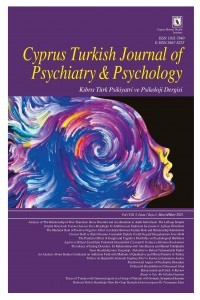Sigarayı bıraktırmak için cep telefonu tabanlı farkındalık müdahaleleri: Randomize kontrollü bir çalışma.
Sigarayı bıraktırma, Cep telefonu mesajı, farkındalık, motivasyon
Cell phone-based mindfulness interventions for smoking cessation:Randominised control study
Smoking cessation, Cell phone message, mindfulness, motivation,
___
- Brewer, J.A., Roy, A., Deluty, A., Liu, T. ve Hoge EA. (2020). Can mindfulness mechanistically target worry to improve sleep disturbances? Theory and study protocol for app-based anxiety program, Health Psychol, 39(9):776-784
- Carlini, B.H., Ronzani, T.M., Martins, L.F., Gomide, H.P. ve Souza, I.C. (2012). Demand for and availability of online support to stop smoking, Revista Saude Publica, 46(6):1074-81
- Chan, E.Y. (2021). Mindfulness and smoking frequency: An investigation with Australian students, Addictive Behaviors Reports, 17;13:100342
- Do, V.V., Spears, C.A., Van Minh, H., Huang, J., Redmon, P.B., Xuan Long, N. ve Eriksen MP. (2020). Perceptions About Mindfulness and Text Messaging for Smoking Cessation in Vietnam: Results From a Qualitative Study, JMIR Mhealth Uhealth, 24;8(6):e17337
- Garrison, K.A., Pal, P., O'Malley, S.S., Pittman, B.P., Gueorguieva, R., Rojiani, R., Scheinost, D., Dallery, J. ve Brewer JA. (2020). Craving to Quit: A Randomized Controlled Trial of Smartphone App-Based Mindfulness Training for Smoking Cessation, The official journal of the Society for Research on Nicotine & Tobacco, 16,22(3):324-331
- Gautam, M., Thakrar, A., Akinyemi, E. ve Mahr, G. (2020). Current and Future Challenges in the Delivery of Mental Healthcare during COVID-19, SN Comprehensive Clinical Medicine, 11,1-6.
- Hebert, E.T., Ra, C.K., Alexander, A.C., Helt, A., Moisiuc, R., Kendzor, D.E., Vidrine, D.J., Funk-Lawler, R.K. ve Businelle, M.S. (2020). A Mobile Just-in-Time Adaptive Intervention for Smoking Cessation: Pilot Randomized Controlled, Journal of Medical Internet Research, 9;22(3):e16907
- Hodder, R.K., Freund, M., Bowman, J., Wolfenden, L., Gillham, K., Dray, J. ve Wiggers, J. (2016). Association between adolescent tobacco, alcohol and illicit drug use and individual and environmental resilience protective factors, BMJ Open, 25;6(11):e012688
- Kashyap, V.K., Dhasmana, A., Massey, A., Kotnala, S., Zafar, N., Jaggi, M., Yallapu, M.M. ve Chauhan, S.C. (2020). Smoking and COVID-19: Adding Fuel to the Flame, International Journal of Molecular Sciences, 9,21(18):6581
- Kralikova, E., Zvolska, K., Stepankova, L., Pankova, A., Felbrova, V. ve Kulovana, S. (2020). Tobacco dependence treatment in the Czech Republic: history, presence and future, Casopis Lekaru Ceskych, 159(3-4):147-152.
- Lachance, C. ve Frey, N. (2020). Non-Pharmacological and Pharmacological Interventions for Smoking Cessation Programs in Youth: A Review of Clinical Effectiveness and Guidelines, Ottawa (ON): Canadian Agency for Drugs and Technologies in Health, https://www.ncbi.nlm.nih.gov/books/NBK562834/
- Lenhart, A. (2015). Teens, Social Media & Technology Overview, Pew Research Center, https://www.pewresearch.org/internet/2015/04/09/teens-social-media-technology-2015/
- Lindson, N., Thompson, T.P., Ferrey, A., Lambert, J.D. ve Aveyard, P. (2019). Motivational interviewing for smoking cessation, Cochrane Database Systematic Reviews, 31;7(7):CD006936
- Moolchan, E.T., Radzius, A., Epstein, D.H., Uhl, G., Gorelick, D.A., Cadet, J.L. ve Henningfield, J.E. (2002). Fagerström test for nicotine dependence and the diagnostic interview schedules: do they diagnose the same smokers?, Addictive Behaviors, 27: 101-3.
- Munoz, R.F., Barrera, A.Z., Delucchi, K., Penilla, C., Torres, L.D. ve Perez-Stable, E.J. (2009). International Spanish/English Internet smoking cessation trial yields 20% abstinence rates at 1 year, The official journal of the Society for Research on Nicotine & Tobacco, 11(9):1025-34
- Myung, S.K., McDonnell, D.D., Kazinets, G., Seo, H.G. ve Moskowitz JM. (2009). Effects of Web- and computer-based smoking cessation programs: meta-analysis of randomized controlled trials, Archives Of Internal Medicine, 25;169(10):929-37
- Patanavanich, R. ve Glantz, S.A. (2020). Smoking Is Associated With COVID-19 Progression: A Meta-analysis, The official journal of the Society for Research on Nicotine & Tobacco, 24,22(9):1653-1656
- Prokhorov, A.V., Machado, T.C., Calabro, K.S., Vanderwater, E.A., Vidrine, D.J., Pasch, K.P., Marani, S.K., Buchberg, M., Wagh, A., Russell, S.C., Czerniak, K.W., Botello, G.C., Dobbins, M.H., Khalil, G.E. ve Perry CL. (2017). Developing mobile phone text messages for tobacco risk communication among college students: a mixed methods study, BMC Public Health, 31;17(1):137
- Rideout, V., Fox, S. ve Trust, W.B. (2018). Digital Health Practices, Social Media Use and Mental Well-Being Among Teens and Young Adults in the U.S., Providence Saint Joseph Health , https://digitalcommons.psjhealth.org/publications/1093/
- Seidman, D.F., Westmaas, J.L., Goldband, S., Rabiu,s V., Katkin, E.S., Pike, K.J., Wiatrek, D. ve Sloan, R.P. (2010). Randomized controlled trial of an interactive internet smoking cessation program with long-term follow-up, Annals of Behavioral Medicine, 39(1):48-60
- Sharma, D. ve Bhaskar, S. (2020). Addressing the Covid-19 Burden on Medical Education and Training: The Role of Telemedicine and Tele-Education During and Beyond the Pandemic, Frontiers in Public Health, 27, 8:589669
- Washington-Brown, L. ve Cirilo, R. (2020). Coronavirus Disease - 2019-nCoV (COVID-19), The Journal of National Black Nurses Association, 31(1),19-25.
- World Health Organization (2008). WHO Report on the Global Tobacco Epidemic, 2008: the MPOWER package, https://apps.who.int/iris/handle/10665/43818
- World Health Organization (2019). WHO report on the global tobacco epidemic 2019: offer help to quit tobacco use, https://www.who.int/publications/i/item/9789241516204
- ISSN: 1302-7840
- Yayın Aralığı: Yılda 4 Sayı
- Başlangıç: 2000
- Yayıncı: Kıbrıs Ruh Sağlığı Enstitüsü
Okullarda performans değerlendirmesi: Meta Analiz çalışması
Yeme Tutumları ve Depresyon Belirtileri İlişkisinde Duygu Düzenleme Güçlüğünün Aracı Rolü
Dezavantajlı Gruplar için Hayvan Destekli Müdahalelere Sistematik Bir Bakış
Akıllı Telefon Bağımlılığı Üzerinde Dijital Sosyal Baskının Rolünü Keşfetmek
Burcu BAYRAK KAHRAMAN, Sevinç MERSİN, Aysun ACUN
Koronavirüs Pandemisi Döneminde Aile Dayanıklılığının Annelerin Risk Faktörlerine Göre İncelenmesi
ÖZEL GEREKSİNİME İHTİYACI OLAN ÇOCUKLARA SAHİP ANNE BABALARDA TRAVMA SONRASI BÜYÜME
